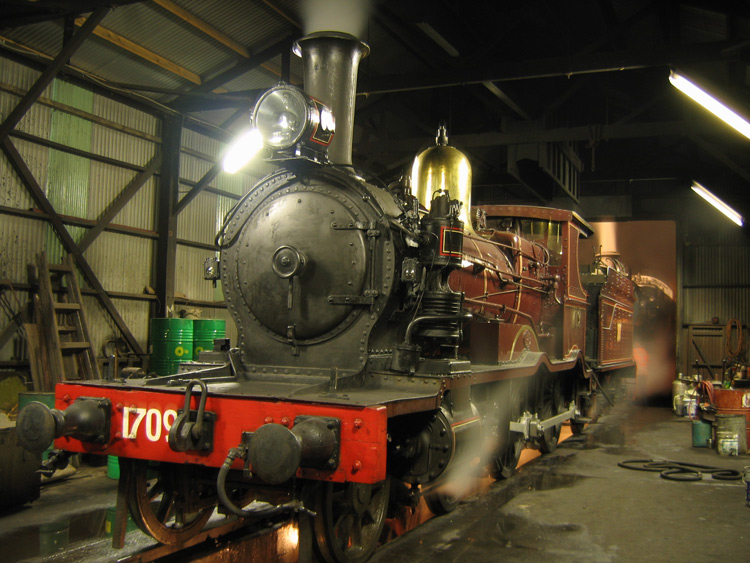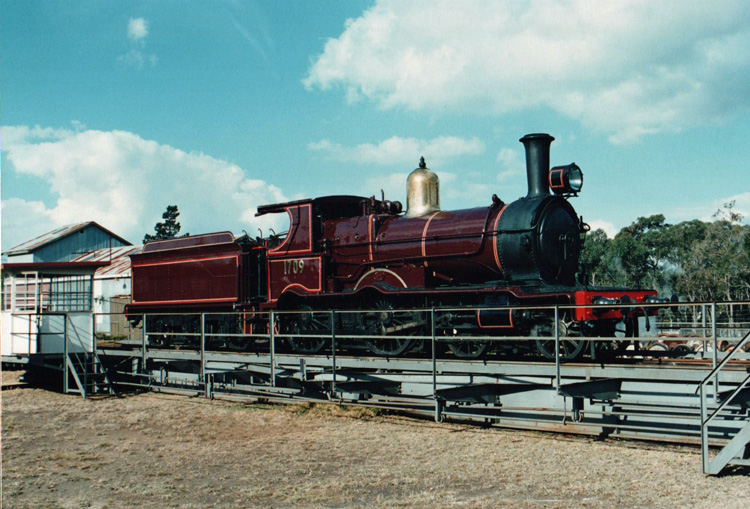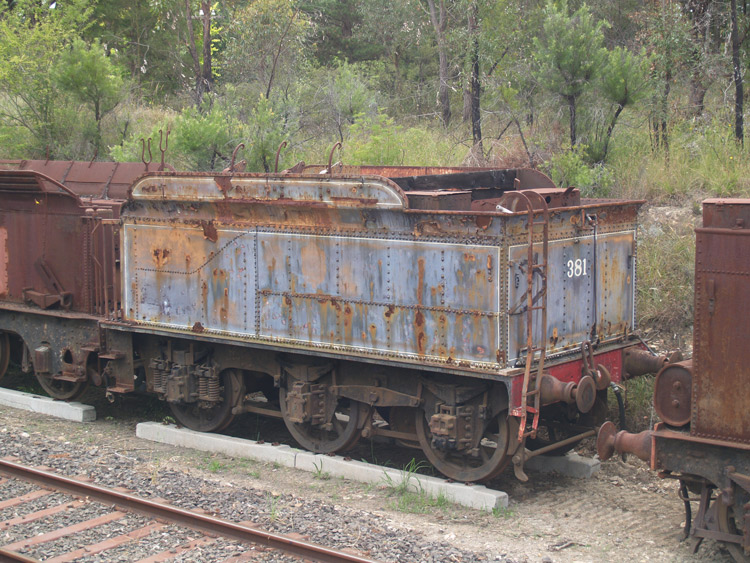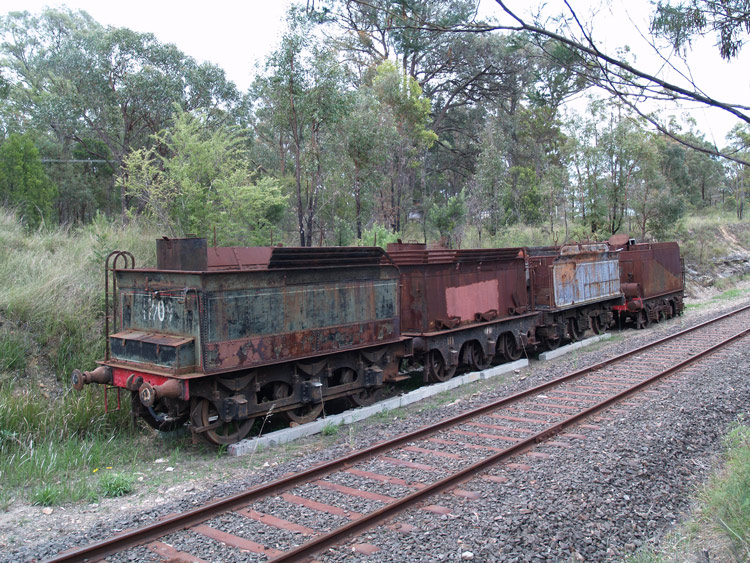|
|
1709 Last of the H(373) class |
|

Jason Smid has kindly
provided this atmospheric photo of 1709 simmering in the NSWRTM’s old workshop at
Thirlmere on 3 September 2005.
|
Builder |
Vulcan
Foundry & Co, Newton-le-Willows, Lancashire |
|
Builder’s Number & Year |
1172 of 1887 |
|
Wheel Arrangement |
4-4-0 |
|
No. in class |
12 |
|
The 12
members of the H(373) / (Z)17-class were built to augment the New South Wales
Government Railways’ existing stud of 4-4-0 passenger locomotives (summarised
below) as a more powerful type was required for the steeply-graded main line
from Sydney to Newcastle and on the Illawarra line from Sydney to Kiama. They were supplied with round-top boilers
and outside cylinders of 19” diameter, together with extended smokeboxes to
help alleviate char build-up during heavy steaming.
The
H(373) class were very handsome locomotives when built and sometimes
described as having a “Great Western Railway” look, but were apparently found
to be too powerful for their weight and hence prone to slipping and damaging the
track. At a later stage they were
rebuilt with Belpaire boilers, shortened smokeboxes and the cylinder diameter
was reduced to 18”. The class moved into
secondary roles with the arrival of the P(6) / (C)32
class 4-6-0 locomotives from 1892 onwards. It
is interesting to reflect that the (Z)17 class
outlived many of the NSWGR’s other 4-4-0 designs, despite being only 12
members strong. While the NSWGR’s
inside-cylinder 4-4-0’s were withdrawn in the 1920’s & 30’s (many
surrendering their tenders to the (C)30T class rebuilds), the
outside-cylinder 4-4-0’s of class C(79) / (Z)12 and H(373) / (Z)17 fared better
with a number retained for mail and passenger duties on lightly-loaded country
trains; perhaps the outside cylinder machines were considered to have
maintenance & operational advantages over inside-cylinder designs. Preserved
loco 1709 was originally numbered H 381 and survived into preservation after
being retained by the New South Wales Government Railways for “Vintage Train”
duties in the early 1960’s. (The last
of its classmates was withdrawn from normal service in 1957 and scrapped in
1962). Photos of 1709 in early 1960’s Vintage
Train duties show it paired with its original H(373)
tender “Tab 381” however this was replaced by P(6) class tender in 1964. After the NSWGR Vintage Train ceased
operation, 1709 passed into the care of the New South Wales Rail Transport
Museum at their Enfield Roundhouse base.
It often wore maroon livery and carried its pre-1924 identity of H 381
during this period. 1709
was withdrawn from NSWRTM tour train duties and placed on static display at
Thirlmere around 1975. After some
years the maroon livery had become patched & worn, so 1709 received a quick
repaint into unlined black during 1988. In 1994 it was selected for repair and
restoration to enable the locomotive to be used during the celebration of 140
years of NSW railways in 1995. Following
this it was returned to static display at the NSWRTM, with the boiler treated
for dry storage. 1709
was again reactivated for the NSW Railways’150 years celebrations in 2005. A high point of this celebration was a
quintuple-headed steam train from Sydney to Moss Vale with 1709 leading 1210,
2705, 3112 & 3526 on 17 September 2005, as seen in this fine YouTube
clip by BelbinVideo. 1709
/ H 381 is now statically displayed at Trainworks where it remains in nominally
operational condition. While it is currently
paired with a P(6) class tender, an original
H(373)-class tender is also stored at Thirlmere and hopefully it will be
repaired for use with 1709 at a future overhaul. Further
information and technical details for the H(373) /
(Z)17-class locomotives can be found on Wikipedia. |

H 381 / 1709 is now
prominently displayed within the exhibition building at Trainworks at the head
of the magnificent Governor’s Carriages.
Alas its current position behind a safety barrier on a
platform road makes photography rather difficult.

The Vulcan Foundry & Co builder’s plate attached to the
wheel splasher. 1 March 2015

Here is an earlier view
(before I bought a digital camera!) showing newly-restored 1709 riding the
turntable at Thirlmere in September 1995.
This area was landscaped
as visitor area during the Trainworks redevelopment,
with the turntable & loco depot relocated
to the southern portion of the Thirlmere site.

A second view of 1709 on
the turntable at Thirlmere in September 1995.
It is attached to a P(6) class tender of the type supplied by Beyer Peacock
& Co with the first 50 members of the P(6) / (C)32-class.

6-wheel tender Tab 473 was
used behind 1709 / H381 from 1964 to around 1987 and is seen in storage at
Trainworks on 23 November 2008.
It was another P(6) / (C)32-class tender as supplied by Beyer Peacock &
Co. with the first order of 50 P(6) class locomotives.
Unfortunately this old tender was sold for scrap by the NSW
Office of Rail Heritage in 2011.

Tender Tab 381 is 1709’s
original tender is seen in
storage at Trainworks on 23 November 2008.
It wears the faded
remnants of lined green livery which 1709 wore in the early 1960’s.
Hopefully this tender will be restored for pairing with
1709 at a future overhaul.

The line-up of 6-wheel
tenders stored alongside the Loop Line on 23 November 2008, having moved there
to make way for the Trainworks redevelopment.
From left to right they
are: Tab 381 (1709’s original tender), a (Z)24-class
tender (now at Dorrigo for 2414), Tab 473 (last paired with 1709) and a rebuilt
(Z)16 tender numbered 3001.
The last two tenders were offered for sale by the NSW
Office of Rail Heritage but, with no heritage buyer, were sold for scrap in
2011.

This view from the John Hurst
collection shows H 381 / 1709 taking water at Waterfall in 1973.
At that stage H 381 was fitted with an ornate copper-top
chimney and oil headlight.

A second view from the John Hurst
collection showing H 381 (with 3526) near Helensburgh on tour train duties
in 1973.
References
|
a |
"A
Compendium of New South Wales Steam Locomotives" compiled by Alex Grunbach, published by the Australian
Railway Historical Society, New South Wales Division, 1989. |
|
b |
Eardley, G. H. 'Locomotives: A
Guide - Enfield Railway Museum', published by the NSWRTM, 1973. |
|
c |
Webmaster's
observation or comment |
Page updated: 8 June 2015
|
Government Railways: |
|
|||||||||
|
Private & Industrial Railways: |
|